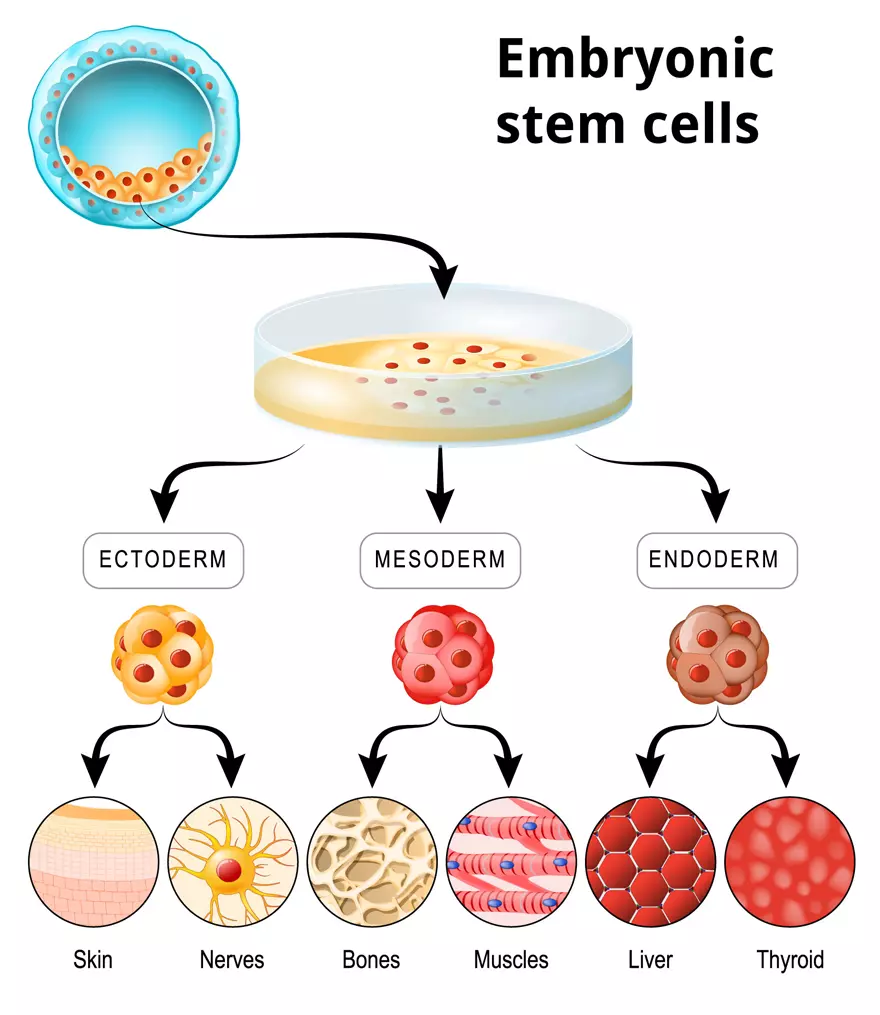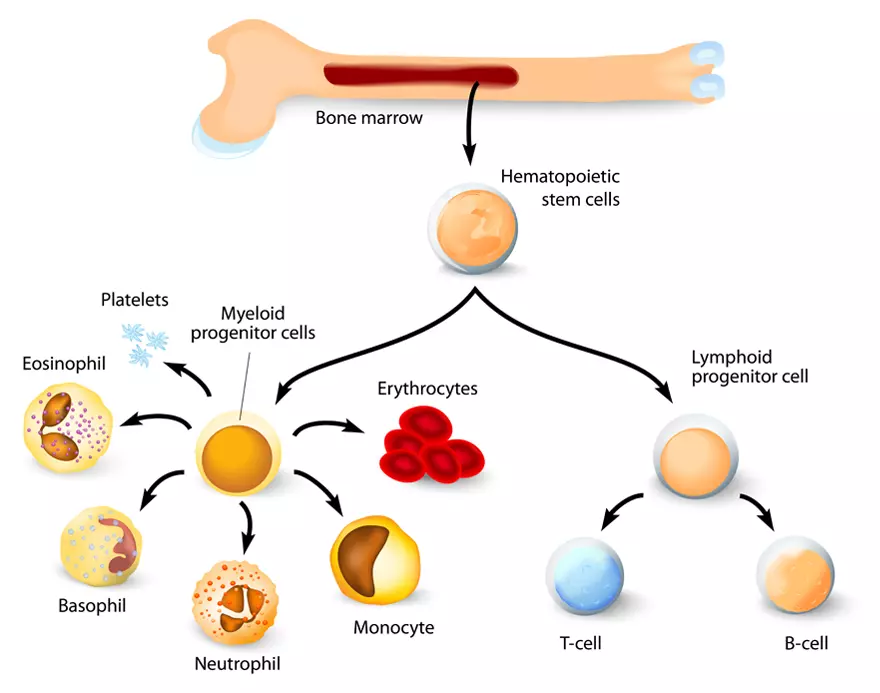You have no items in your shopping cart.
Stem Cells
Stem Cell Differentiation Background
Stem cells are undifferentiated, precursory cells that can differentiate into a variety of cells and proliferate indefinitely. They are the earliest type of cell in all cell lineages and can be distinguished from progenitor cells, which cannot divide indefinitely, as well as precursor or blast cells. These cells usually differentiate into a single cell type. Stem Cells are found in both embryonic and adult organisms, but they have slightly different properties and give rise to different groups of cells, as illustrated below.
Human Embryonic Stem Cell Differentiation

In mammals, approximately 50–150 cells make up the inner cell mass during the blastocyst stage of embryonic development, at around days 5–14. During development, they subsequently differentiate into all the body's cell types (making them pluripotent). This process is initiated by the differentiation into the three germ layers at the gastrulation stage:
- Ectoderm – origin of neuronal and pigment cells.
- Mesoderm – progenitor of muscle, blood, and kidney cells.
- Endoderm – responsible for the rise of certain immune, lung and pancreatic cells.
Within the life sciences, these cells can be isolated and cultured in vitro, they can be kept in the stem-cell stage and are known as embryonic stem cells (ESCs).
Adult Stem Cell Differentiation Background
Adult stem cells are a small minority of cells; they are vastly outnumbered by the progenitor cells and terminally differentiated cells that they become. Stem Cell Research developed from initial work conducted by Canadian biologists Ernest A. McCulloch (1) and James E. Till (2) at the University of Toronto in the 1960s.
The main ‘adult’ stem cells, particularly within mammalian species are as follows:
- Hematopoietic stem cells – replenish blood and immune cells.
- Basal cells – maintain the skin epithelium.
- Mesenchymal stem cells – which maintain bone, cartilage, muscle, and fat cells.
Stem Cell Differentiation – Bone Marrow

Adult stem cells are predominantly found in a few key locations in the body, such as those in the bone marrow or gonads. They exist to replenish the rapidly lost cell types, they are multipotent or unipotent, meaning they only differentiate into a few cell types or one cell type.
Stem Cell Therapy
Stem cell therapy has been used for many years to treat or prevent a disease or condition. Bone marrow transplant is a form of stem cell therapy that has been used for many years and has proven to be effective in clinical trials. Stem cell implantation has shown to help in strengthening the left-ventricle of the heart, as well as retention of heart tissue in patients who have previously had heart attacks.
| Advantages | Disadvantages |
|---|---|
| Stem cell treatments may lower symptoms of the disease or condition that is being treated. | Stem cell treatments may require immunosuppression, due to radiotherapy prior to the transplant to remove the person's previous cells, or due to an autoimmune issue that targets the patient's stem cells. |
| Alleviating symptoms may allow patients to reduce the drug intake of the disease or condition. | Pluripotency in certain stem cells can make it difficult to obtain a specific cell type. A lack of differentiation uniformity also contributes to this issue. |
| Stem cell treatment may also provide knowledge for society to further stem cell understanding and future treatments. | Stem cells transplants can result in tumour development. Pluripotency has been linked to tumour formation, especially in embryonic stem cells and induced pluripotent stem cells. |
Developments in the field of Stem Cell research
For over 20 years it has been possible to culture and differentiate human embryonic stem cells (ESCs). Sources for isolating ESCs have been restricted in certain European countries and North American countries, such as Canada. However, other nations such as the UK and China have actively aided stem cell research. A team led by Shinya Yamanaka discovered a process that allows the conversion of mature body cells back into stem cells. The resulting cells generated from this method are called induced pluripotent stem cells (iPSCs) (3). With the capability to differentiate into virtually all cell types and to grow vigorously like ESCs, iPSCs have an enormous potential for both pharmaceutical and clinical applications. Patient-specific iPSCs can be generated for use as disease models for further pathological studies.
References
- Becker AJ, McCULLOCH EA, Till JE (February 1963). "Cytological demonstration of the clonal nature of spleen colonies derived from transplanted mouse marrow cells". Nature. 197 (4866): 452–4. doi:10.1038/197452a0. hdl:1807/2779. PMID 13970094. S2CID 11106827.
- Siminovitch L, Mcculloch EA, Till JE (December 1963). "The distribution of colony-forming cells among spleen colonies". Journal of Cellular and Comparative Physiology. 62 (3): 327–36. doi:10.1002/jcp.1030620313. hdl:1807/2778. PMID 14086156. S2CID 43875977.
- Takahashi K. Yamanaka S. Induction of pluripotent stem cells from mouse embryonic and adult fibroblast cultures by defined factors. Cell. 2006; 126: 663-676 DOI:https://doi.org/10.1016/j.cell.2007.11.019

